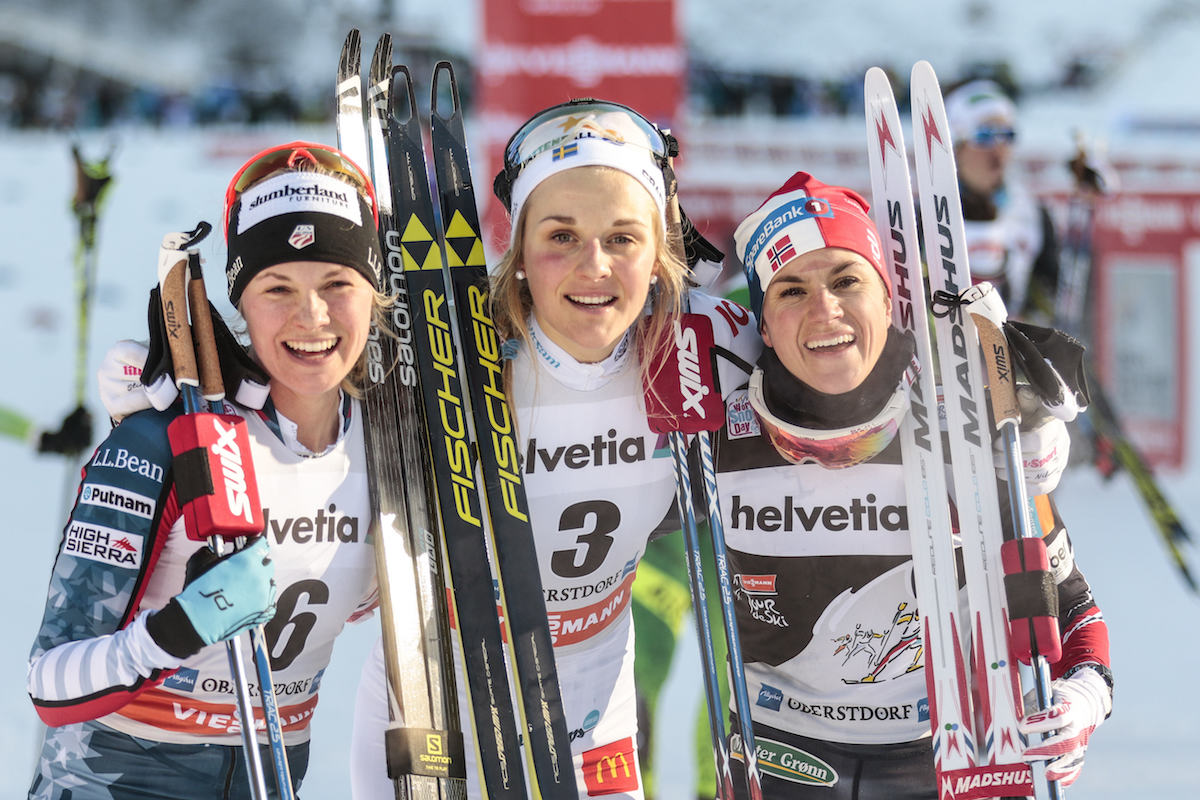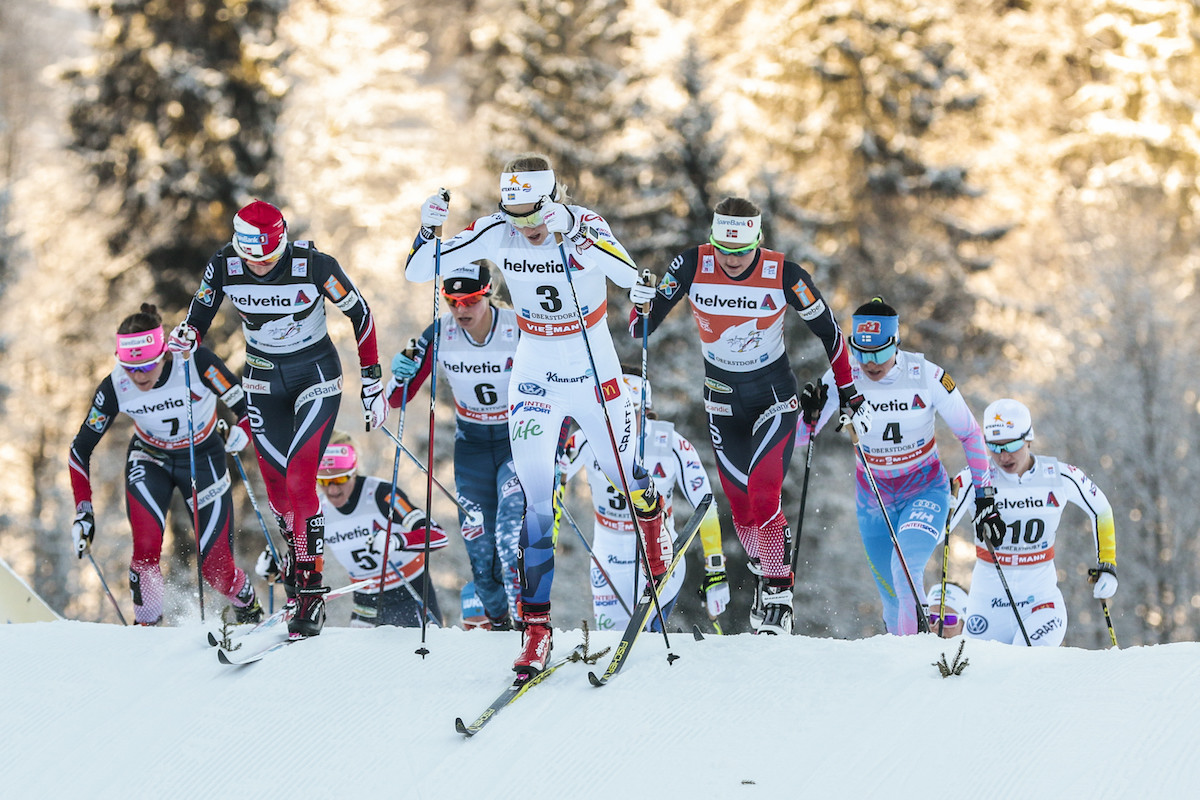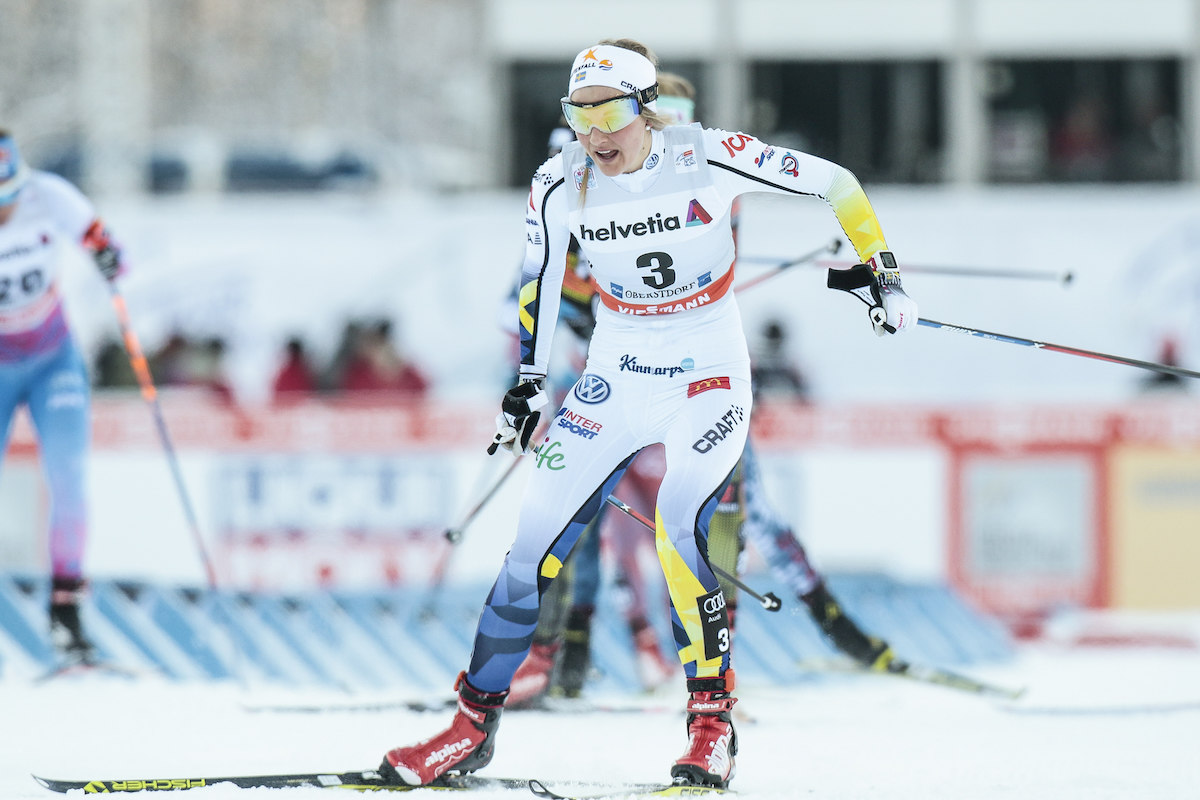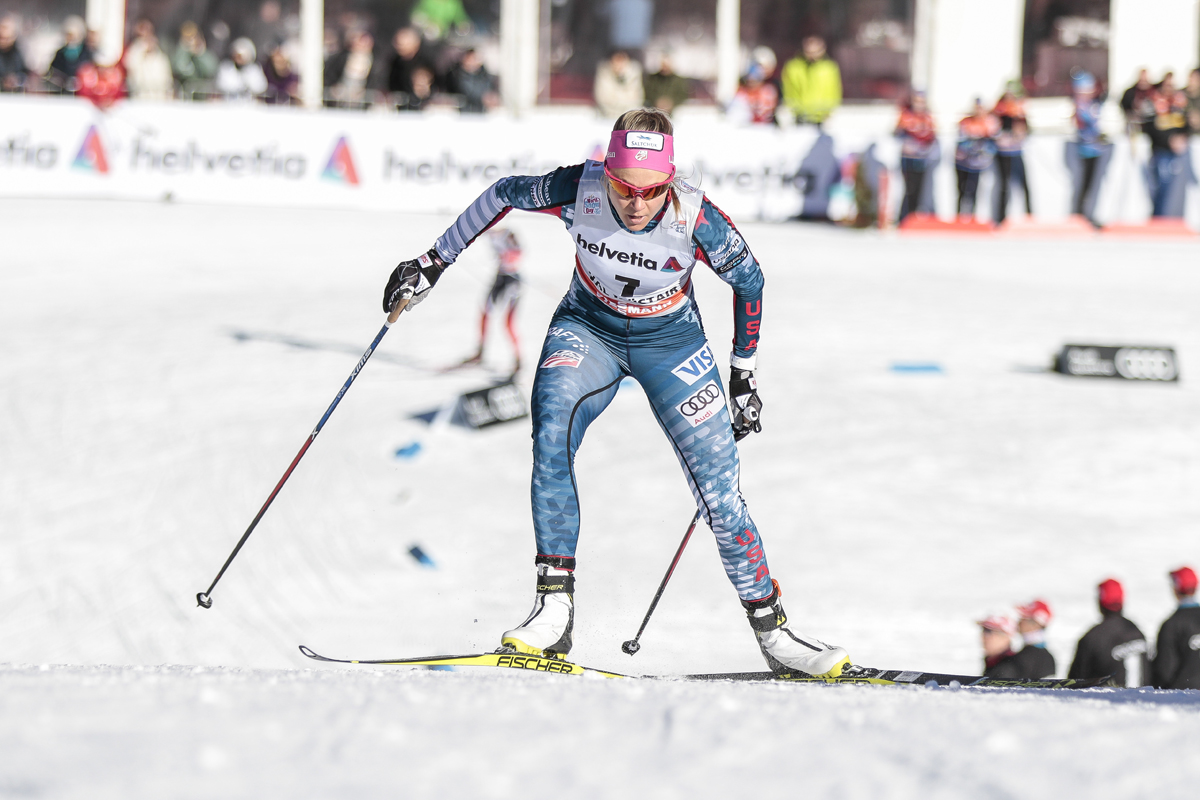
In the final kilometer of Tuesday’s 10-kilometer skiathlon in Oberstdorf, Germany, American cross-country skier Jessie Diggins saw a chance to grab her second World Cup win of the season.
It came on the final lap up a 35-meter tall climb, just a few hundred meters from the finish. All she had to do was go over the top and ace the next downhill – a downhill where she had been flying by other racers all day.
If only it were so easy.
“I had decided I was going to go ahead and try to win it,” Diggins said in a phone interview after. “I wanted my own lane, but I didn’t have any room. Luckily, I got in behind [Sweden’s Stina Nilsson] and was able to have a pretty clear shot at [the uphill]. But then I didn’t ski the final downhill the way I had in every practice. I kind of chickened out, my legs were really tired, and I was just so scared of making a mistake and falling, ruining everything.”
Nilsson was a good pick to follow, though. She crested the towering hill before anybody else, including the favored Norwegian women. Despite the lactate burning in her legs, Diggins stuck to her over the top.
Shooting off the downhill and into the finishing stretch, Diggins tuck-skated furiously as Nilsson picked up her poles. They battled all the way to the line, with Diggins crossing just 0.2 seconds back for second place.

“I wish I could do it again, because I know if I had skied that downhill the way I can, I would have given myself a better chance,” she lamented. “That said, I am obviously thrilled with how it went. But you know, at the end of a race, you always play back. What would I have changed? You ask, what have I learned from today?”
Second place was still good for Diggins’s first podium at the 10 k distance.
Packing It Up
It came on an unusual day. After seemingly years of one woman — usually Therese Johaug or a Norwegian teammate — shattering the pack in long mass-start races, World Cup saw something a bit unusual in this Tour de Ski stage: an entire skiathlon where the top four, count ‘em four, racers were never separated by more than three and a half seconds.
“It was definitely a very different race, with the whole lead group being such a big pack for so long,” Diggins said. “That was really cool, and very different. It’s not something we’re used to. I don’t know if it was the new snow on the course that was just conducive people sticking together more, or what, I don’t know, but it was really cool.”
Norwegian coach Vidar Lofshus speculated that perhaps after coming down from altitude – the previous races were held in Val Mustair, Switzerland – more of the field was feeling fresh and feisty.
But regardless of the cause, pre-race favorites like Norway’s Heidi Weng were unable to break away from the competition. And that meant tight quarters for the women – something the men’s field is far more used to – and not everyone was happy.
“It was a lot of bumping into each other here and there,” Weng told NRK. “If there’s a distance race here again then the course has to be wider. There is barely enough room for one person up the hill. It was goofy.”
That’s called ski racing, though, Diggins thought.
“I’m not going to name names, but somebody full-on used both hands and shoved me sideways, and I was like, all right, we need to keep our hands to ourselves,” she said. “I’m sure I did my share — not on purpose — of accidentally stepping on someone’s ski or their pole. It was wide enough for really two people. And when you’re in a pack of twenty and you’re trying to pass, and you come into the bottom of the hill thinking, oh there’s enough room for three and it turns into two, that is racing.”
In all that chaos, it paid to stay out of trouble and keep a cool head. Sweden’s Nilsson did just that, earning her second win of this year’s Tour and her first ever World Cup victory in a distance race.

“I always liked the skiathlon,” Nilsson said, according to the FIS news service. “It was a perfect day for me. My shape was great, everything was perfect. I knew if I wanted to be on the podium I had to be in the front.”
To take the win, she had to hold Diggins in the final meters.
“I felt Diggins was pushing very hard,” Nilsson said, according to FIS. “I thought I had more power than Jessie before the finish.”
And she did: just enough to take a 0.2-second win.
Norway’s Weng was third (+1.5), and teammate Maiken Caspersen Falla fourth (+3.3).
And then, after Falla: another charging American. Bjornsen held off hometown favorite Nicole Fessel to claim fifth place.
“She had her PR, big breakthrough, and that is so cool,” Diggins said of her teammate. “Sadie skied like such a champ, and I don’t want that to get lost either. She is such a consistent skier, she is always up there, and she’s going to be on that podium so soon.”
Another Norwegian teammate expected to be near the top missed big. Ingvild Flugstad Østberg broke a pole on the final climb.
“It’s at the bottom of the final hill where I as about to step out from the pack and increase my speed, but then the opposite happened and I crashed into someone else and broke my pole,” she explained to VG. “Then it becomes all about crawling/pulling myself to the finish line and losing as little time as possible… It’s extremely annoying, especially in a Tour. In a single race you lose a place or a podium finish, but here it’s about the Tour standing and seconds. I’m losing a lot because of this.”
She finished the day 13th, 19.2 seconds behind Nilsson, and lost the overall Tour leader’s bib to Nilsson as well. That puts her in third in the Tour standings, 12.4 seconds behind Nilsson and 8.4 behind second-place Weng.
“These things aren’t supposed to happen, that you’re falling behind, but I have to think positive now,” Østberg told VG. “About new opportunities and new races where I can cut the gap.”
Best-Ever Day for Americans

“I didn’t even know that she was right there,” Bjornsen said of the German she edged at the finish. “I bobbled and almost fell over, similar to what happened in my sprint race in Val Mustair. And I was like, ‘Oh no, not this again. I’m almost going to fall over.’ I didn’t realize that [Fessel] was there until almost at the finish line when I saw that somebody was right there. I was just trying to focus on getting across the line.”
It was a tight photo finish, but Bjornsen ultimately claimed fifth place. It’s a best-ever result for her on the World Cup.
“It’s fun to have a good race, but it’s way better when you have a good race with your teammate,” Diggins said. “And I think it’s cool to have a good race in the skiathlon, because it is proving to yourself that you are an all-rounder, which is something that I’ve always worked on, and I don’t want to speak for her, but I know Sadie feels the same way. We like to sprint, like to do distance, like to do it all, want to be able to do everything.”
Bjornsen was coming off a “blow-up” in the 5 k classic in Val Mustair. On Sunday, she went out hard and ended up spit out by the altitude. But the team wasn’t worried that her blowup would harm her for a second race in a row.
“Normally, when you have an athlete who is tired, they don’t bounce back that quickly,” U.S. Ski Team Women’s Coach Matt Whitcomb said. “So I think our guess that it was just a full-blown the other day at altitude was spot on. Not surprised to see her feeling good today.”
One remnant of the Val Mustair races was bib 22. Racers start Tour de Ski mass starts in the order they are ranked in the Tour, rather than their World Cup ranking. This put Bjornsen farther back in the mass start then she was used to.
“I was trying to just stay super-positive and just be a little more patient today,” Bjornsen said. “Trying to wait to find some openings. I could tell that I felt strong and I felt good.”
By the halfway point Bjornsen was up to 12th position, and then she let it rip.
“Generally in pursuits in the past, I’ve struggled a bit because I’ve always felt I’m stronger in the classic part,” Bjornsen said. “But I am starting to almost prefer switching onto skate. It’s exciting for me. As soon as I felt strong in the skate section, I knew it could be an awesome day. I just went for it after that.”
She was motivated, too, by the course’s big final hill, where she’s had success before.
“In Oberstdorf two years ago, there was a 3 k skate prologue and I got seventh, and at the time that was like my best skate result ever, by a long, long ways,” she said. “I think that kind of started my confidence that I could skate ski. I always get a little belief on that hill, and I was kind of just channeling my past results and just trying to tell myself I can ski hills strongly too.”
Both Diggins and Bjornsen enjoyed some of the fastest skis in the field.
“It was pretty cool to have some really great skis today because a [skiathlon], in the middle of the Tour de Ski, is exceptionally challenging for the waxing crew — just having to put together so much testing,” Bjornsen said. “So I definitely want to give some great credit, because if you watch the race at all, you can see we had quite amazing skis.”
“Just a huge thanks to our staff, obviously they did an incredible job,” Diggins agreed. “If you think the Tour is hard on athletes, it’s doubly hard on the staff, and they don’t even get any sort of thank-you’s, usually. I mean, they get them from us, but … they don’t get the same recognition for all of their hard work, and I think what they’re doing everyday is incredible. Not to mention, they have to tear down and rebuild the wax room.”
Next Steps for the U.S. Team
The women compete in a 10 k skate pursuit on Wednesday, something many are keenly excited for.
Pursuits are one of Diggins’s favorite formats. She will start more or less alone: in fifth position, 12 seconds behind Krista Parmakoski of Finland and 18 ahead of Kathrine Harsem of Norway.
“Tomorrow, I’m just going to go hunting, and chasing, and that is what I love to do,” Diggins said. “I love being given a goal, this really hard test, and I’m just going to go out there and try with all my might. Obviously, the girls that I am chasing down are incredible, incredible athletes. I’ve had some amazingly fun times skiing with Krista Parmakoski, where she’ll lead the climbs, and I’ll lead the flats and downhills. We ski really well together, so if there’s a chance I can catch her and work with her, that will be so fun. But I’m not any presumptions, I’m just going to go out there and try my hardest.”
“Nobody closes a gap more effectively than Jessie,” Whitcomb laughed. “So if she’s feeling good, she’s unlikely to be alone for too long.”
For Bjornsen, the pursuit brings four more cracks at her believe-in-yourself hill.
“I actually really excited,” Bjornsen said. “I just looked at the standings and it looks like I will get to ski with Nicole [Fessel] and [Yulia] Tchekaleva, so definitely I’m really looking forward to testing my skate skills again.”
Other Americans also have another shot. Kikkan Randall finished 28th in the skiathlon (+43.8) and Liz Stephen 30th (+59.9). Rosie Brennan clocked in 45th (+2:14.5).
“We didn’t get her skate skis going today,” Whitcomb said of Stephen. “So that was a little unfortunate and it’s a bummer for her. I know she was excited to attack that skate leg, but we struggled a little bit with [skis for] both Rosie and Liz on the skate section today. So they are both much better than their results indicated today.”
Randall summed up her race as “decent,” in an email to media outlets.
“I struggled to kick my skis in the classic and lost touch with the lead pack on the 2nd classic lap,” Randall wrote. “Had good energy in the skate though and was almost able to bridge back up to the back of the main pack. I was happy with the way my body felt today but a little frustrated with my classic skiing.”
Results | Tour standings (through Stage 3)
Chelsea Little
Chelsea Little is FasterSkier's Editor-At-Large. A former racer at Ford Sayre, Dartmouth College and the Craftsbury Green Racing Project, she is a PhD candidate in aquatic ecology in the @Altermatt_lab at Eawag, the Swiss Federal Institute of Aquatic Science and Technology in Zurich, Switzerland. You can follow her on twitter @ChelskiLittle.



